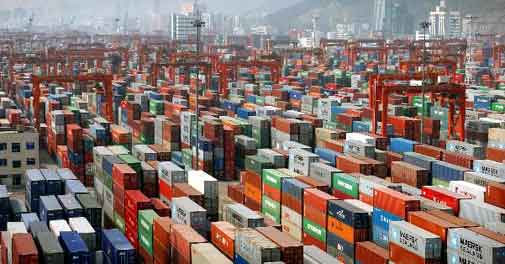
New Delhi- Exports declined for the fourth-consecutive month by 10.3 per cent year-on-year to USD 34.98 billion in May, while the trade deficit widened to a five-month high of USD 22.12 billion.
According to the data released by the commerce ministry on Thursday, key export sectors recording negative growth include petroleum products, gems and jewellery, engineering goods, ready-made garments of all textiles and chemicals.
Imports also declined 6.6 per cent, six-month in a row, to USD 57.1 billion against USD 61.13 billion in the same month last year, the data showed.
The trade deficit in May 2022 stood at USD 22.13 billion. The last high was in December 2022, when the gap was USD 23.89 billion.
Cumulatively, exports during April-May this fiscal contracted by 11.41 per cent to USD 69.72 billion, while imports declined 10.24 per cent to USD 107 billion.
Briefing reporters on the data, Commerce Secretary Sunil Barthwal said headwinds still continue at the global trade front as there is a “whole lot of” recession and slowdown in many countries.
The fall in economic growth in certain developed markets has impacted import demand, he said, adding there is also low demand in OECD nations.
However, he expressed hope that the demand will pick up in developed countries.
“We are expecting that slowdown conditions should improve and demand should pick up,” Barthwal said.
He also informed that the ministry is working on a trade strategy to promote exports.
As part of that, the Department of Commerce, Department for Promotion of Industry and Internal Trade (DPIIT), Invest India and Indian missions abroad would focus on 40 countries.
These countries, including the US and European Union nations, account for 85 per cent of India’s total exports.
There would be a focus on promoting exports along with catering to the needs of the domestic market, he said, adding both departments “are kind of forging an alliance in terms of promoting investments and exports and for that, both are working a trade and investment strategy”.
Initially, they would be focusing on 11 countries and 8-9 commodity groups.
Under the strategy, they will also participate in some major exhibitions abroad, where teams from these departments would also go and do buyer-seller meets.
In fairs like World Food Show and World Spices Congress, there would be reverse buyer-seller meets for the industry.
“So, now, there is a focused strategy to promote exports…We are bringing out the strategy…We will be using a multi-pronged strategy…We are talking about a twin strategy of export promotion and import substitution. Both industrial policy and trade policy would work in sync,” he added.
The merchandise trade deficit for April-May 2023 was estimated at USD 37.26 billion against USD 40.48 billion during April-May 2022.
“India’s trade performance, after witnessing very strong growth in 2022-23 has shown declining trends as compared to the high base of last year as the pace of growth in global merchandise exports moderated significantly in 2023, as persisting geopolitical tensions and monetary tightening induced recessionary fears have led to a decline in consumer spending across advanced nations,” the ministry said.
Export sectors, which recorded positive growth, include smartphones, electronic goods, and pharmaceuticals.
Smartphone exports in April increased to USD 1.06 billion against USD 498.26 million in the same month last year.
During April-May 2023, shipments of electronic goods rose by 48 per cent to USD 4.54 billion.
The decline in import value of petroleum, vegetable oil, coal, coke and briquette, has been largely on account of the decline in commodity prices. The fall in gold import has been largely on account of import duty, it added.
Oil imports in May dipped by about 6 per cent to USD 15.62 billion. Gold imports in the month under review declined by 38.71 per cent to USD 4 billion.
Exports of petroleum products contracted by about 30 per cent to about USD 6 billion.
Follow this link to join our WhatsApp group: Join Now
Be Part of Quality Journalism |
Quality journalism takes a lot of time, money and hard work to produce and despite all the hardships we still do it. Our reporters and editors are working overtime in Kashmir and beyond to cover what you care about, break big stories, and expose injustices that can change lives. Today more people are reading Kashmir Observer than ever, but only a handful are paying while advertising revenues are falling fast. |
| ACT NOW |
| MONTHLY | Rs 100 | |
| YEARLY | Rs 1000 | |
| LIFETIME | Rs 10000 | |












